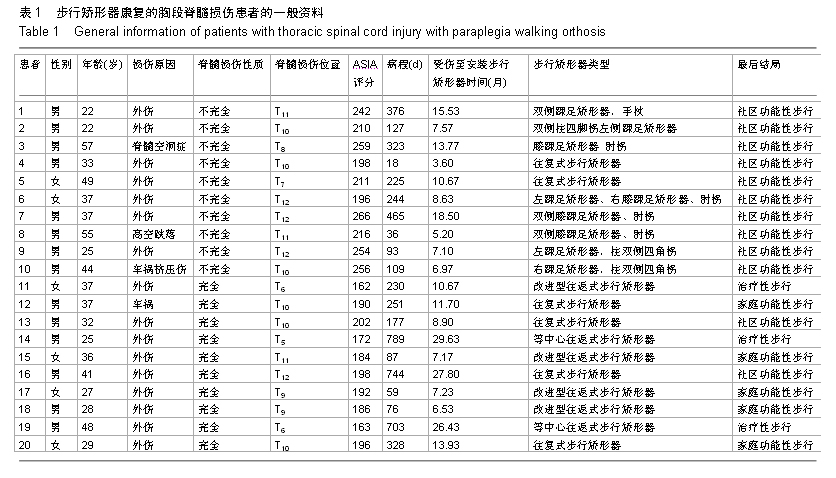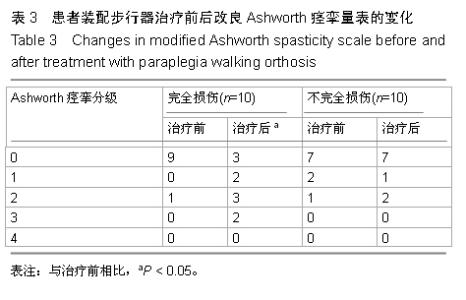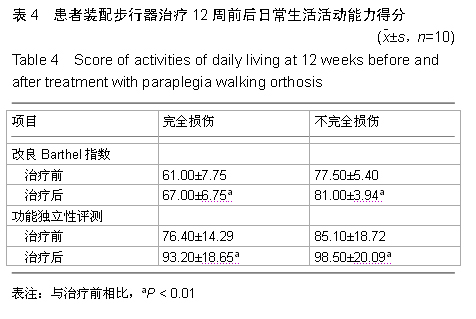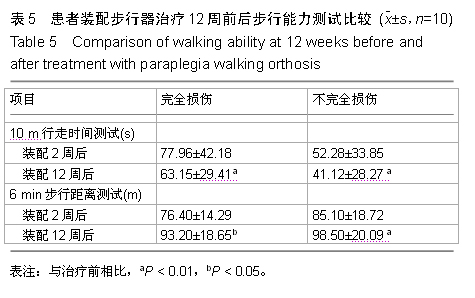| [1] 胥少汀,郭世绂.脊髓损伤基础与临床[M]. 2版.北京:人民卫生出版社,2002:575-594.
[2] 孙嘉利,钟世镇,欧阳亚涛,等.重心移动式步行矫形器对截瘫患者膀胱和肠道功能的影响[J].南方医科大学学报,2008,28(6): 1019-1021.
[3] 王俊,杨振辉,刘四文,等.C6-T6脊髓损伤患者应用往复式步行矫形器的疗效分析[J].中国康复医学杂志,2008,23(2):126-129.
[4] 唐丹,裴国献,李奎成,等.重心移动式截瘫步行矫形器对脊髓损伤患者日常生活活动能力及生存质量的影响[J].中国康复医学杂志,2009,24(11):985-988.
[5] Johnson WB, Fatone S, Gard SA. Modeling the walking patterns of Reciprocating Gait Orthosis users with a novel Lower Limb Paralysis Simulator. Conf Proc IEEE Eng Med Biol Soc. 2011;2011:7841-7844.
[6] Arazpour M, Hutchins SW, Ahmadi Bani M, et al. The influence of a rocker sole adaptation on gait parameters in spinal cord injury patients ambulating with the advanced reciprocating gait orthosis - a pilot study. Disabil Rehabil Assist Technol. 2015;10(1):89-92.
[7] Arazpour M, Bani MA, Chitsazan A, et al. The effect of an isocentric reciprocating gait orthosis incorporating an active knee mechanism on the gait of a spinal cord injury patient: a single case study. Disabil Rehabil Assist Technol. 2013;8(3): 261-266.
[8] 帅浪,冯珍.截瘫步行矫形器在胸腰椎脊髓损伤患者中的应用[J].中华物理医学与康复杂志,2012,34(8):612-614.
[9] 孙嘉利,唐丹,欧阳亚涛,等.重心移动式步行矫形器对截瘫患者步行功能的影响[J].中国组织工程研究与临床康复,2007,11(13): 2437-2440.
[10] 美国脊髓损伤协会,国际脊髓损伤学会,李建军,等.脊髓损伤神经学分类国际标准(2011年修订)[J].中国康复理论与实践,2011, 17(10):963-972.
[11] Haas BM, Bergström E, Jamous A, et al. The inter rater reliability of the original and of the modified Ashworth scale for the assessment of spasticity in patients with spinal cord injury. Spinal Cord. 1996;34(9):560-564.
[12] Mishra C, Ganesh GS. Inter-rater reliability of modified modified Ashworth scale in the assessment of plantar flexor muscle spasticity in patients with spinal cord injury. Physiother Res Int. 2014;19(4):231-237.
[13] Furlan JC, Noonan V, Singh A, et al. Assessment of disability in patients with acute traumatic spinal cord injury: a systematic review of the literature. J Neurotrauma. 2011; 28(8):1413-1430.
[14] Ploypetch T, Dajpratham P. Change in quality of life of disabled patients after intensive inpatient rehabilitation at Siriraj Hospital. J Med Assoc Thai. 2011;94(10):1245-1251.
[15] Cohen JT, Marino RJ, Sacco P, et al. Association between the functional independence measure following spinal cord injury and long-term outcomes. Spinal Cord. 2012;50(10):728-733.
[16] Barbetta DC, Cassemiro LC, Assis MR. The experience of using the scale of functional independence measure in individuals undergoing spinal cord injury rehabilitation in Brazil. Spinal Cord. 2014;52(4):276-281.
[17] van Hedel HJ, Wirz M, Curt A. Improving walking assessment in subjects with an incomplete spinal cord injury: responsiveness. Spinal Cord. 2006;44(6):352-356.
[18] Enright PL. The six-minute walk test. Respir Care. 2003;48(8): 783-785.
[19] 李志君,郭小志,王凯斌,等.胸腰段椎体骨折脊髓损伤65例康复效果观察[J].中国康复理论与实践,2011,17(2):176-177.
[20] 郑宏,张建奎,马丙祥.踝足矫形器材料学特点及其临床应用[J].中国组织工程研究与临床康复,2010,14(51):9643-9646.
[21] 孙嘉利.重心移动式步行矫形器的基础与临床应用研究[D].广州:南方医科大学博士学位论文,2008.
[22] 吴宗耀.机器人与截瘫患者的行走康复[J].中华物理医学与康复杂志,2011,33(8):624-629.
[23] 陈文远.截瘫步行器的仿生效果[J].中国组织工程研究与临床康复,2011,15(30):5650-5652.
[24] 唐丹,刘四文,刘海兵,等.不同步行矫形器在下胸段脊髓损伤中的应用探讨[J].中国康复医学杂志,2004,19(8):572-574.
[25] 石芝喜,唐丹,欧阳庆军,等.往复式步行矫形器对改善脊髓损伤患者步行能力及日常生活活动能力的作用[J].中国康复理论与实践,2009,15(2):117-119.
[26] 唐丹,裴国献,刘浩,等.往复式截瘫步行器及其在脊髓损伤患者中的应用[J].中国脊柱脊髓杂志,2010,20(1):75-78.
[27] 杨俊玲,魏毅,张建国,等.下肢矫形器对脊髓损伤患者日常生活活动能力和步行能力恢复的辅助作用[J].中国临床康复,2005, 9(42):68-69.
[28] 高峰,弥振刚,李强,等.E-mag电磁控制膝关节矫形器在截瘫患者中的应用[J].中国康复,2013,28(4):270-271.
[29] 黄杰,黄晓琳,陈勇,等.康复治疗对脊髓损伤患者功能恢复的影响[J].中华物理医学与康复杂志,2003,25(11):679-682.
[30] Chen WL, Chang WH, Chen CC, et al. Ambulation study of a woman with paraplegia using a reciprocating gait orthosis with functional electrical stimulation in Taiwan: a case report. Disabil Rehabil Assist Technol. 2009;4(6):429-438.
[31] Arazpour M, Gharib M, Hutchins SW, et al. The influence of trunk extension in using advanced reciprocating gait orthosis on walking in spinal cord injury patients: A pilot study. Prosthet Orthot Int. 2014. in press.
[32] 孙嘉利,欧阳亚涛,唐丹,等.截瘫步行器对截瘫患者日常生活活动能力的影响[J].中国康复医学杂志,2007,22(7):609-611.
|













